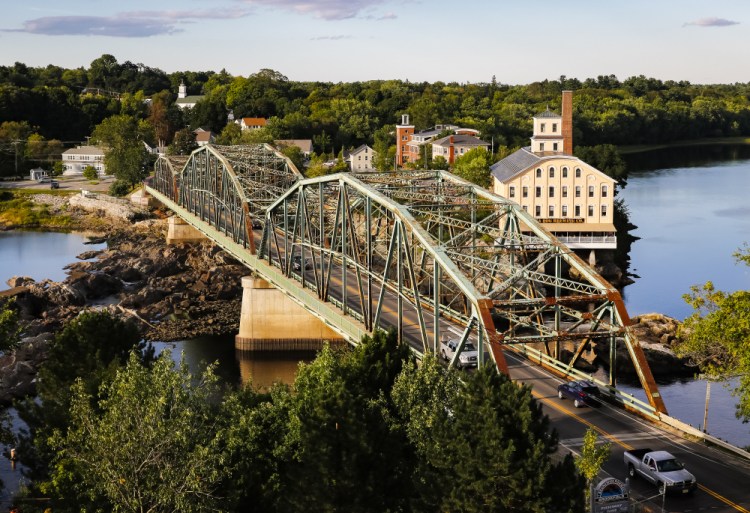BRUNSWICK — Heavy trucks will be prohibited from using a key bridge linking Brunswick and Topsham after inspections showed rapid deterioration of structural steel on the span over the Androscoggin River.
A 25-ton limit will be posted on the Frank J. Wood Bridge Thursday morning, the Maine Department of Transportation said Monday. The posting was prompted by regularly scheduled inspections in June and a follow-up inspection this month that downgraded the condition of the deck and superstructure from fair to poor condition on the bridge that carries Route 201, linking Maine Street in Brunswick and Main St. in Topsham.
“The ongoing and fast deterioration of the structural steel, particularly in the vicinity of the floor beam ends and connection plates, requires immediate repairs,” the DOT said, adding that the posting is expected to last several years until the bridge is replaced or rehabilitated.
“While this unplanned posting does not affect most noncommercial vehicles, five-axle trucks and other commercial vehicles will follow a bypass detour of one mile,” the agency said.
The detour will take tractor-trailers east on Route 1 to the Brunswick-Topsham Bypass, where Route 196 crosses the Androscoggin River.
Bridge maintenance engineer John Buxton said the special inspection in August confirmed concerns about corrosion and deteriorating supports on the nearly 80-year-old bridge, which currently has no weight restrictions.
“We had some corrosion issues, we thought it would be more prudent to post the bridge given its condition and age,” Buxton said.
However, a local citizens’ group formed to preserve the existing span expressed skepticism about the posting, saying it seems to be timed to support the DOT’s position that the bridge needs to be replaced rather than rehabilitated.

Vehicles that exceed the weight limit will have to detour east on Route 1 to the Brunswick-Topsham Bypass, where Route 196 crosses the Androscoggin River.
Weight limits will mostly affect tractor-trailers, and not large vehicles like ambulances and fire trucks or delivery vans. The DOT will have to do retrofitting and repairs until the bridge is replaced or restored, Buxton said.
Known locally as “The Green Bridge,” the span has an average daily traffic count of 19,256 vehicles, of which about 5 percent are commercial trucks, the DOT said.
Built in 1937, the bridge was rehabilitated in 1985 and additional improvements were made to the superstructure, rail and curbs in 2006.
TRIP, a Washington D.C.-nonprofit that analyzes bridge conditions, reported last year that 15 percent of Maine’s bridges are structurally deficient. A bridge is structurally deficient if there is significant deterioration to its decks, supports and other major components. Such bridges are often posted for lower weight or closed to traffic, the report said.
The department is planning to replace or rehabilitate the Brunswick-Topsham bridge within the next two years.
But the group of Brunswick and Topsham residents opposed to replacing the bridge, which is eligible for National Register of Historic Places designation, is questioning the DOT’s new weight limit.
The Friends of the Frank J. Wood Bridge was established after the DOT proposed a $13 million bridge replacement in April.
Scott Hanson, spokesman for the group, said Monday he was surprised the limit was imposed because until now there had been no significant concerns about the structural conditions of the bridge. Monday’s announcement comes as the group is seeking a full environmental review and consideration of alternatives to replacing the span.
The Maine DOT’s preliminary recommendation is to replace the bridge, but that proposal must go through what is known as a federal Section 106 process to ensure the historic nature of the bridge is considered.
“I find the timing very convenient, I look forward to our own engineers having the opportunity to look at the new data and see what their interpretation is,” Hanson said.
The group has published a 21-page report that stated the bridge was not structurally deficient, and rehabilitation could give a projected additional lifespan of up to 100 years, which is longer than DOT projections. DOT spokesman Ted Talbot said the proposal to replace the bridge signifies the department’s concern about its condition. The DOT is determining the best way to improve the bridge and wants feedback from businesses and groups like the Friends, he added.
“We have nothing to gain by leaning one way or another toward rehabilitation or replacement,” Talbot said.
“We want to do what’s right, we want to do what’s safe, that’s how we approach all projects.”
Send questions/comments to the editors.



